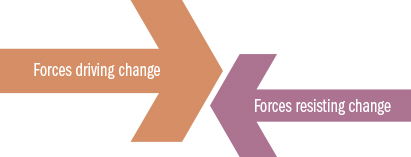4.9 Overcoming resistance to change
Resistance to change was discussed in the Preliminary course; however, it is worth revisiting as businesses are changing in response to the external environment, globalisation and the need to maintain a competitive advantage through operations. Kurt Lewin was an American social psychologist and is regarded as one of the founders of modern psychology. He is perhaps best known for developing Force Field Analysis. Lewin’s Force Field Analysis identified that a business has driving forces and restraining forces. Driving forces are those that push towards the need for change.
Restraining forces are those that hold the business back and resist any change that is attempted. The challenge for management is to identify and develop strategies to overcome the resisting forces. In operations the resisting forces will be related to costs and inertia. Costs may be associated with purchasing new equipment, redundancy payments for employees replaced by capital or technology, retraining costs to operate new equipment and technology, and reorganisation costs associated with changing the layout of the plant, factory or office.
There is also resistance owing to inertia, as people in the business can react emotionally to change and, rather than embrace the challenges and opportunities it offers, merely wish for things to remain as they are.
Purchasing new equipment
Management needs to be aware of technological change and assess its application to the business. Not all technological developments or equipment are appropriate for implementation at the business. Managers must assess the cost of the installation of the equipment, its impact on production and the expected profitability generated by the change. There will be long-term impacts on the financial position of the business, often because new equipment and technology may need to be funded from debt finance. Therefore, there may be financial resistance to changing technology in the business. Purchasing new equipment is an internal influence, because managers decide how to use it in the business. Several technological changes may not be simple to implement but may result in a long-term reduction in operating costs, decreased time delays in communication and faster decision-making processes. Old equipment may still have a value and may be sold to create space for new equipment.
Ultimately, the operations manager must consider all the costs associated with purchasing new equipment and weigh up the long-term cost savings against the short-term impact on the business.
Redundancy payments
An employee redundancy occurs when an employee is no longer required because their job no longer exists or they have been replaced by new technology or equipment. Their role may have become automated and they are unable to find a position in another area of the business. In Australia redundancy payments are legally required in the following circumstances:
- There is an award or enterprise agreement covering redundancy pay.
- The business is not a small business, having more than 15 employees.
- The employee has worked full-time and has worked continuously for 12 months or more.
From 1 January 2010 the National Employment Standards stated the redundancy entitlement of employees based on their base rate of pay.
| No. of years of service | Redundancy pay of: |
|---|---|
| 1–2 years | 4 weeks |
| 2–3 years | 6 weeks |
| 3–4 years | 7 weeks |
| Maximum payment | |
| 9–10 years | 16 weeks |
If a large number of long-time serving employees are made redundant by changes to the business operations, then redundancy payments represent a significant cost of implementing change.
Retraining
Labour is often considered to be a business’s most valuable asset. When changes are made to the business, another cost consideration is the cost of retraining staff so that they are productive, and work efficiently and effectively. Even when retraining is successful, there will still be a period of adjustment as employees improve their familiarity with new equipment, new technology or changes in systems and procedures. It may take an extended period before employees are back to the productivity levels they had prior to any changes. These are the more hidden costs of change.
Without adequate training the benefits of new equipment, technology or new processes will not be fully realised. The implementation of comprehensive training programs can go a long way to overcoming employee resistance to changes.

Reorganising plant layout
With the acquisition of new equipment and technology at a factory or business, there may need to be a reorganisation in the way equipment is placed so that manufacturing occurs in the most efficient manner and bottlenecks are avoided. A business may change from a process layout using assembly lines to a product layout where the product remains in a fixed spot and all the inputs and components converge at a central location for final assembly. The plant layout may have to change to manage more product variety or volume. Significant changes will occur to the layout if the business moves from a highly repetitive operation to one that uses batches or individual jobs to make products for customer orders.
Other examples could be reorganisation of displays in a shop to achieve a better flow of customers through the store or changing the layout of the dining room and kitchen in a restaurant to fit in more tables and prevent congestion as staff move around serving customers.
The costs of reorganising can be a disincentive to change, as it can require halting production while equipment is physically moved. The larger the equipment and more complicated the plant layout, the longer it will take to restart operations and generate sales again.
Inertia
There can also be resistance to change owing to inertia. Internal stakeholders such as owners, managers and employees can become comfortable in a stable environment, as there is a feeling of security and predictability. Change can create uncertainty and risk and therefore employees may resist it, due to fear of deskilling, job loss, higher workloads and loss of their familiar work environment. Owners and managers may also have fears about the financial future of the business and whether change will enable the business to be more competitive. If the business has had a history of ‘change for change’s sake’ or has failed to capitalise on previous changes, then inertia will be a greater resisting force.


Operations management has to identify as many forces for change as possible and use its skills of effective management to create a positive culture for change. There needs to be an understanding of the driving forces. Globalisation, technology, demographics, social attitudes, the law, economic growth and competitors are all external drivers of change. Internal sources can occur with new products because when they are developed there may be changes in the way the business’s production is organised. A possibility of increased automation drives change in the business. Managers need to motivate and communicate with staff, encourage participative decision-making, provide training and counselling, negotiate, possibly manipulate or even coerce. Strategies that management may use to overcome resistance to change could include retraining programs, work teams and a flatter organisational structure.